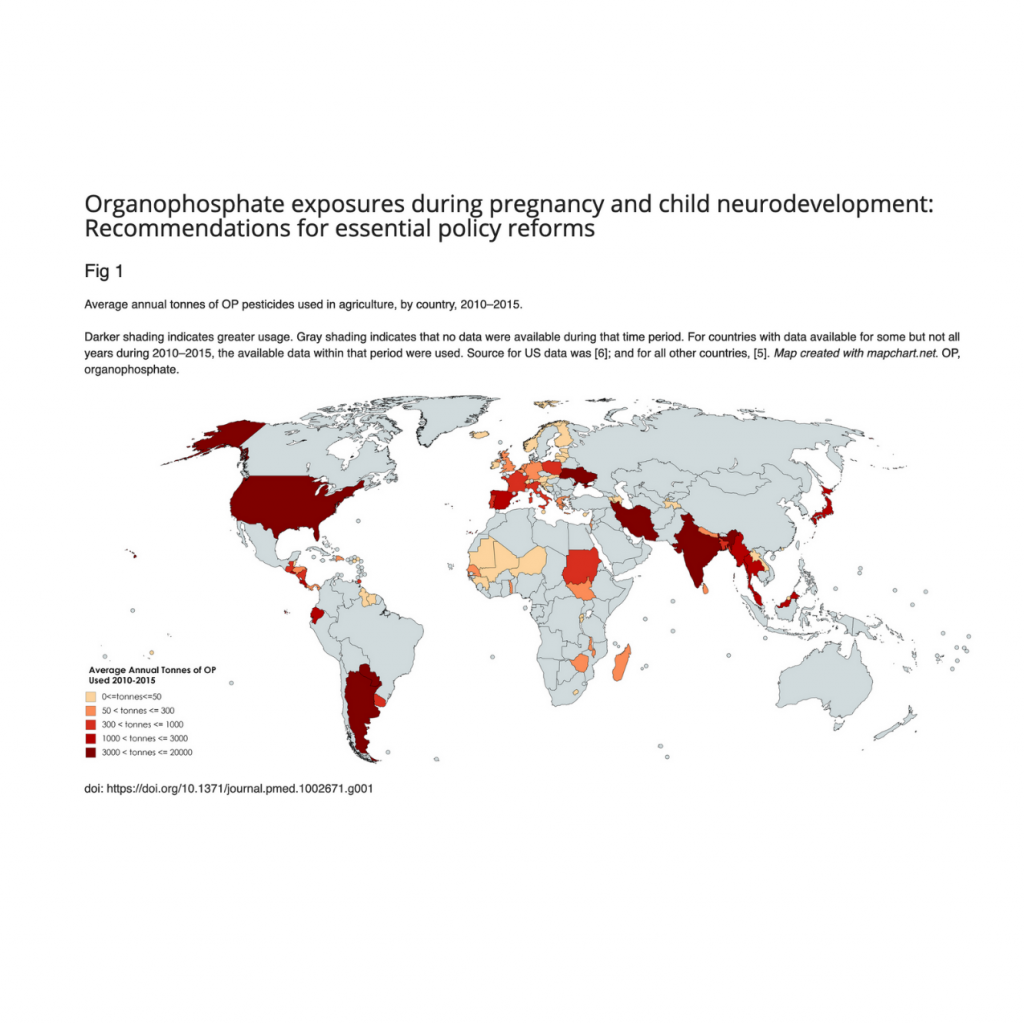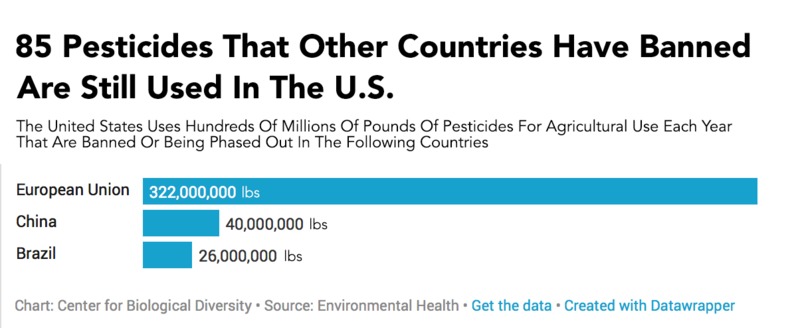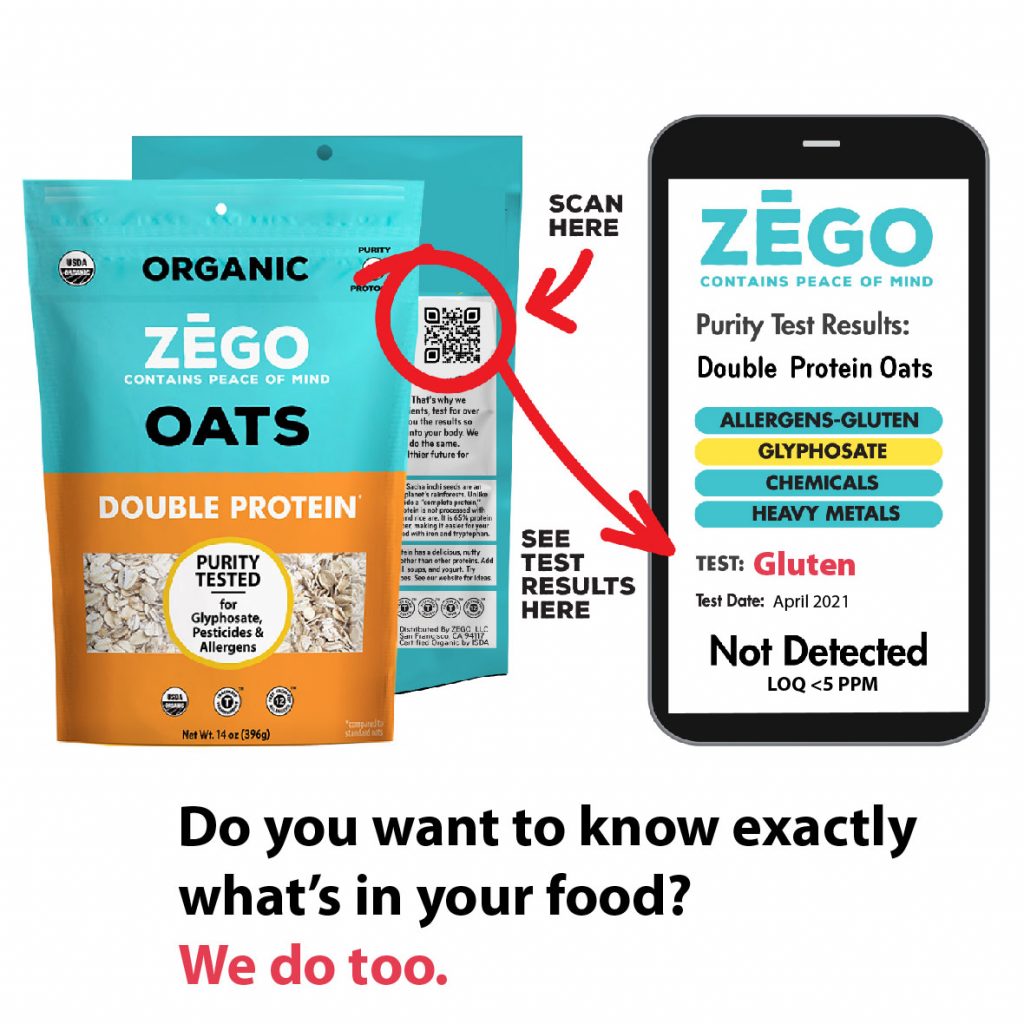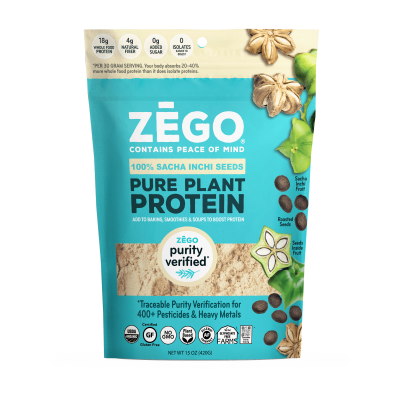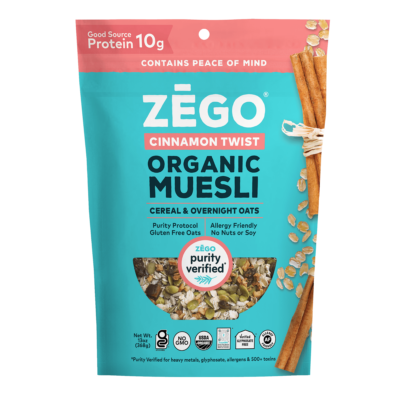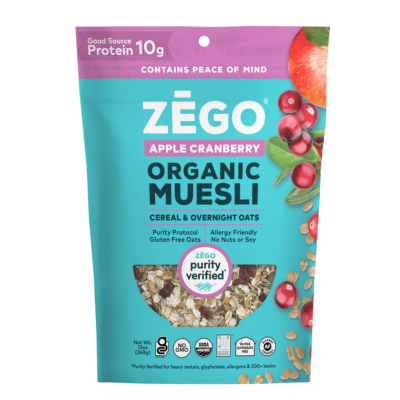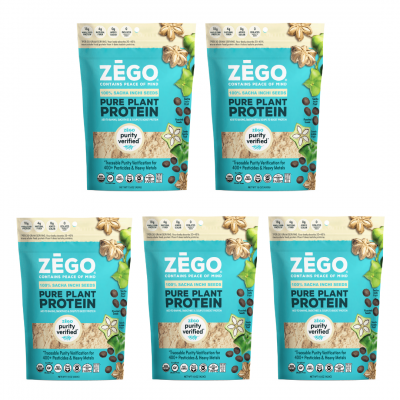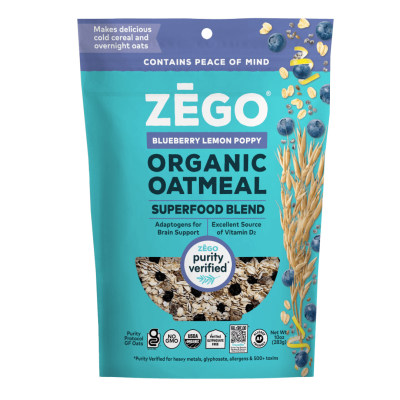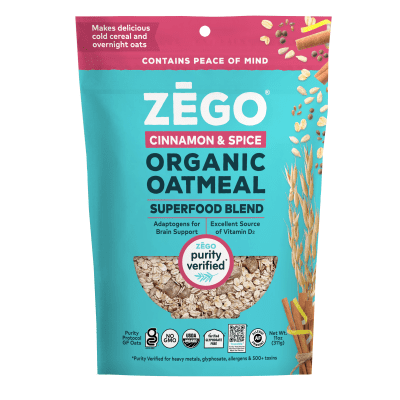Last Updated on May 17, 2021 by Colleen
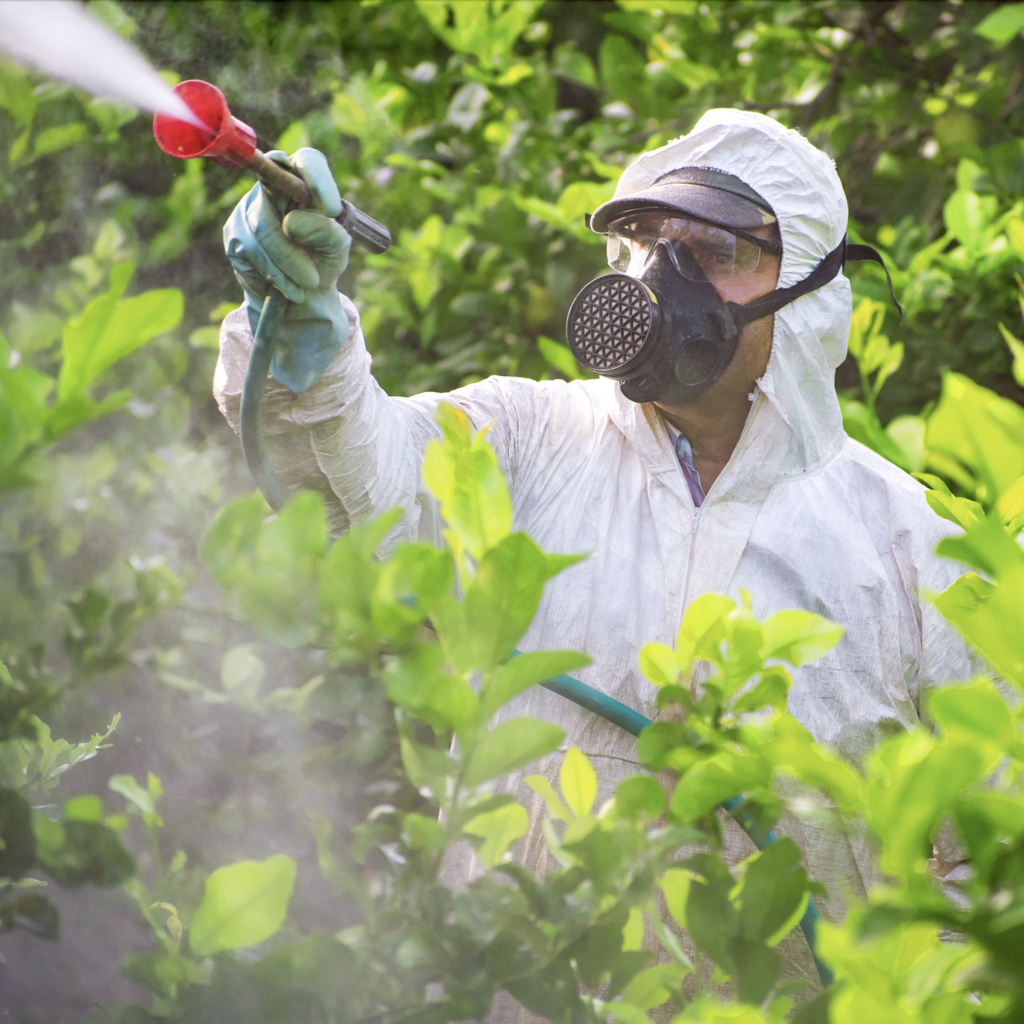
Chlorpyrifos is one of the most toxic agricultural chemicals. But the last administration stopped a move to ban its use. Now a U.S. court steps in to give the EPA a directive, and a very short timeframe to act.
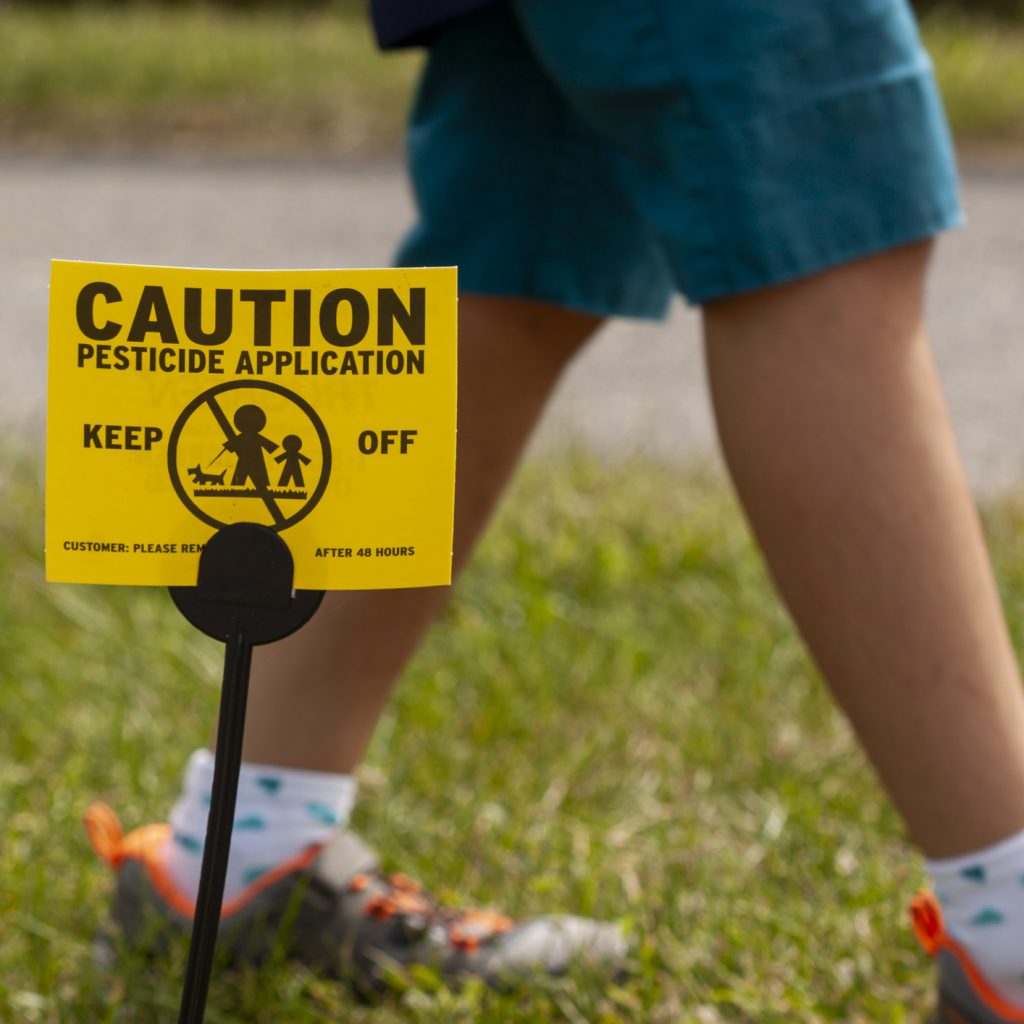
How Toxic is Chlorpyrifos and Who is at Risk?
Dow Chemical patented chlorpyrifos as a pesticide in 1966. It is an organophosphate chemical. Farmers, groundskeepers, and exterminators have used it for 65 years. (To go straight to what you can do to protect yourself and influence the EPA’s decision, scroll down to “How Can You Protect Your Loved Ones from Toxic Chemicals?”)
It kills insects by inhibiting the essential enzyme activity that enables the messages that travel through nerve cells. Chlorpyrifos drifts through the air and poisons the lungs of people exposed to it. It also spreads its poison to people by clinging to fruits and vegetables and grass.
Tragically, it has proven to cause developmental damage even with a small exposure in fetuses and small children. Acute exposure can cause neuromuscular symptoms, seizures, lung failure, paralysis, and death. It is also toxic to bees and crustaceans.
How Do You Get Exposed to Chlorpyrifos?
Despite this toxicity, farmers, exterminators, and grounds keepers in the U.S. have used chlorpyrifos to control pests on
- corn
- soybeans
- fruit and nut trees
- Brussel sprouts
- cranberries
- broccoli and cauliflower
- golf courses
- turf
- termite control
- roach and ant traps
What Other Countries Have Banned It?
Many countries banned this toxin. And yet, the U.S. has continued using it to the present day. Here is the timeline.
- Singapore in 2009
- South Africa in 2010
- Denmark 2012
- European Union 2020
Why Hasn’t the U.S. Banned Chlorpyrifos?
Dow Chemical has lobbied hard for many years to keep chlorpyrifos on the market in the United States. The company asserts it is safe for use. And yet, the EPA has not been able to find a safe threshold of exposure. In fact, Dow paid a $2 million fine to the State of New York for claiming its product was safe. Here’s a quick timeline.
- 1989 OSHA set a maximum exposure level but it was later reversed by the U.S. Court of Appeals.
- 2000 The industry reached an agreement with the EPA to voluntarily restrict the use of chlorpyrifos near children.
- 2003 Dow Chemical paid a fine to NY State for claiming the chemical was safe.
- 2007 The Pesticide Action Network and Natural Resource Defense Council appealed to the EPA to ban chlorpyrifos.
- 2015 A U.S. Court of Appeals told the EPA to ban chlorpyrifo, stating the EPA had failed to show the chemical met legal safety requirements.
- 2016 The EPA decided to ban the chemical despite Dow Chemical’s persistent claims that it is safe and critical to growers.
- 2017 The Trump Administration’s Sec. of Agriculture Scott Pruit revoked the EPA ban. Pruitt claimed he had not met with Dow Chemical executives prior to revoking the ban. But it was later revealed he had met with them dozens of times and specifically told them he would revoke the ban.
- 2017 California adds chlorpyrifos to its Prop 65 list of toxic chemicals and set minimum exposure levels at .025PPB. The American Academy of Pediatrics protests the Administrations lack of movement on the ban, stating the chemical’s well-established danger to children.
- 2018 The U.S. Court of Appeals told the EPA to ban chlorpyrifos within 60 days but the ruling was appealed by the Trump Administration.
- 2020 California banned chlorpyrifos. Thailand bans the use of chlorpyrifos and paraquat and moves to ban imported foods grown by farmers using these chemcals. The US and Brazil appeal to the WTA to force Thailand to reverse its ban. it completely within 60 days.
Who’s to Blame for the Poisoning of America?
The history of chlorpyrifos is a lesson in the danger to people and our planet of taking on one toxic chemical at a time. Dow Chemical introduced chlorpyrifos to the market over 55 years ago. It’s been poisoning fetuses, children, and adults ever since. As far back as 1989 the U.S. government showed public concern over the chemical as seen in the OSHA exposure limits. And twenty years ago the industry publicly admitted it was toxic to children by agreeing to usage restrictions.
Yet, lawsuit after lawsuit, research evidence be damned, court orders disregarded, the EPA failed to protect the people and country it is chartered to protect. And, yes, the delay of the ban over the last five years is due to direct and malicious actions of the Trump Administration. But a handful of other Administrations — Republican and Democrat — could have banned this poison years ago and did not.
What Can We Learn about Glyphosate from the Chlorpyrifos Story?
The lesson is clear. We cannot achieve a cleaner world fighting one chemical at a time. As much as we know some chemicals like glyphosate and chlorpyrifos are perhaps more toxic or pervasive than some others, we cannot cherry pick the handful of worst offenders and try to pick them off one by one. There simply isn’t enough time (unless you think a standard of 50 or more years from introduction to ban to be your measure of success). We must get to the core of the problem.
- Companies must prove chemicals are safe before they are allowed to introduce them on the market.
- Consumers should have a right to know if there is toxic residue on their food.
- Because of their position between farms and consumers, brands, suppliers, and distributors should be the intermediary that requires testing from the farms. They also should test their final product for toxic residue and provide complete transparency to consumers. Finally, that transparency to consumers has to be provided in an actionable format — at a time when they are making purchasing or eating decisions. Consumers should not have to contact a customer service person to request the information.
How Can You Protect Your Loved Ones from Toxic Chemicals?
- Buy organic whenever possible but especially produce that you eat that cannot be peeled.
- Soak your produce in a solution of water with a bit of apple cider vinegar or baking soda or both.
- Buy from companies you trust. Avoid cheap food. Cheap can mean the farmer used a lot of chemicals to increase their yield so they can keep prices low.
- Ask brands you love to test their food and make the results publicly available.
- Contact the EPA and ask them to ban chlorpyrifos and to require chemical companies to prove their products are safe before they can be used. Consider tweeting them at https://twitter.com/epa.
Does ZEGO Test for Chlorpyrifos?
Yes! We do and have since we introduced our purity testing back in 2018. You can see our results on our pesticide panels for each product on our Food Safety tab on our website, or by scanning the QR code on any of our packages. This is exactly the type of testing and transparency all brands should commit to. Why? Because if consumers aren’t informed about the prevalence of toxic residue in our agriculture system and on their food, they won’t have the information and inspiration to demand better. And, better is what we have to strive for every day.
Some of the information in this blog came from Wikipedia, which has extensive information on the history and toxicity of this chemical.
Colleen Kavanagh is the founder and CEO of ZEGO, a company that seeks to inspire changes in the food system so it better nourishes all people and our planet. She spent 20 years working to better nourish low-income children through improved public policies and programs, working for Congressman George Miller in Washington, DC and various anti-hunger nonprofits. She founded the nonprofit www.abettercourse.org. In 2013, she decided the only way to better nourish the most vulnerable is to leverage consumer demand through the marketplace to regenerating the food system and protect the most vulnerable. And that, lead to her starting ZEGO.
-
Organic Gluten Free Oats (14oz bag)$8.99
-
Organic Plant Based Protein Powder (15oz bag)$29.99 — or subscribe to save 10%
-
Organic Gluten-Free Muesli: Nut Free Cinnamon Twist (13oz)$9.99 — or subscribe to save 10%
-
Organic Gluten Free Muesli: Apple Cranberry (13oz)$9.99 — or subscribe to save 10%
-
Organic Plant Protein (5 bags, 15 oz each)$129.95 — or subscribe to save 5%
-
Organic Oatmeal Superfood Blueberry Lemon Poppy 1 Bag$8.99
-
Organic Oatmeal Superfood Cinnamon Spice 1 Bag$8.99
-
Regenerative Organic Oatmeal – (21 oz.)$8.99
🌾 What is Purity Protocol?
And why does it matter if you’re gluten-free?
Oats are naturally gluten-free, of course, but they can easily get contaminated with wheat at every step — from farm to package:
🚜 Farming: Oats are often grown near or after wheat, leading to grain mix-ups in the field.
🏭 Processing: Many facilities use the same equipment for wheat and oats.
📦 Packaging: Oats may be packed alongside gluten-containing grains.
Unlike conventional oats, which rely on machines to try to sort out gluten-containing grains like wheat and barley, ZEGO oats are grown using a more rigorous and preventative approach called Purity Protocol, a patented farming method used to prevent gluten cross-contact in the field.
Here’s how it works ⬇️
🌱 Our partner farmers save seeds from the previous year’s crop, reducing unintended cross-contact
✅ Our oats are grown from a special variety that is significantly shorter than wheat and barley.
👀 As the plants grow (but before they form grains), farm workers hand-pull any taller sprouts — removing the risk of gluten grains from entering the harvest.
🧪 Then we test each batch down to 5 parts per million (ppm)
Our dedicated facility is free from gluten and the top allergens. No peanuts, no wheat, no dairy, no tree nuts, no soy, no milk, no eggs, no sesame, no sulfites, no celery, no corn, and no mustard. Our packaging has no corn derivatives.
💚 The result?
Some of the cleanest, safest oats you can buy — grown with care to nourish and protect your family.
👉 Curious about our testing? Just scan the QR code on any ZEGO package or visit our website to see your oats’ results. Have questions? Drop them in the comments below or send us a DM!
Sep 26

🌱 Why Purity Verified Matters 🌱
We love to hear when our customers are enjoying our oatmeal! Thank you, Robert E. for sharing what you love about ZEGO! He said,
“Great taste and the highest quality. They are the only brand I know that actually tests for every contaminant and publishes the results.”
At ZEGO, “Purity Verified” isn’t just a label—it’s a promise. Our breakfast foods and protein powder are tested by a third-party lab for glyphosate, heavy metals, and 500+ toxins. Then, we publish the results so you know exactly what you’re eating.
Because food should give you peace of mind—not questions. 💚
👉 Scan the QR code on the front of any ZEGO package to see the test results for yourself.
Sep 25

🎉 GIVEAWAY ALERT! 🎉
We’re celebrating clean, safe, and delicious food with a special giveaway! One lucky winner will receive:
🥣 A ZEGO Variety Prize Pack
✨ A ZEGO-branded Stanley Cup—perfect for keeping your favorite beverages hot or cold on the go!
Entering is easy:
– Follow @zegofoods
– Like this post 💚
– Tag a friend who loves safe, nutritious food (each tag = 1 entry!)
– Bonus: Share this post to your story for an extra chance to win! 🌟
📅 Giveaway ends October 1, 2025. Winner announced in our stories!
Good luck!
Sep 23

🎉 We’re so excited to be part of the @wickedglutenfree expo in New England! 🎉
📍 Fitchburg, MA
🗓 Saturday, Sept 20
⏰ 10:00 AM – 4:30 PM
Stop by our table at the country’s biggest gluten-free expo to check out what ZEGO has to offer and grab exclusive coupons to use on your next purchase. 🥣✨
It’s the perfect opportunity to explore trusted gluten-free products and connect with the community. 💚
Who’s planning to attend?
Sep 19

👋 Hello from The Baking Expo (IBIE)!
We’re thrilled to be here at the world’s largest baking industry event, connecting with so many innovators, bakers, and food professionals who share our passion for raising the bar in food safety, nutrition, and sustainability.
Consider this a little slice of life from #IBIE – where inspiration is rising all around us! 🍞✨
At ZEGO, we believe every ingredient matters. That’s why we’re here showcasing our Purity Verified oats, muesli, and regenerative oats – all tested for over 500 toxins and allergens – because everyone deserves food they can trust.
💚
Sep 17

🌾 Farm Visit Spotlight 🌾
Last month, Colleen and Cybele had the joy of visiting the Romsa Brothers Farm in Wyoming, as part of our mission with CIVC [Collaborative Integrated Value Chain]! Part of CIVC`s mission is to create a supply chain pull for millet, a highly nutritious grain that is used in organic and regenerative farming as a cover crop for other grains, like gluten-free oats! 🌱 As fellow oat lovers, we all benefit from more people eating millet!
Not only does millet help with weed control and support healthy soil, it’s also naturally gluten-free, rich in fiber and minerals like magnesium and phosphorus, and thrives with less water than many other grains. A win for both people and the planet. 💚
Have you ever tried millet? What did you think? Let us know in the comments below!
Sep 15
![🌾 Farm Visit Spotlight 🌾
Last month, Colleen and Cybele had the joy of visiting the Romsa Brothers Farm in Wyoming, as part of our mission with CIVC [Collaborative Integrated Value Chain]! Part of CIVC's mission is to create a supply chain pull for millet, a highly nutritious grain that is used in organic and regenerative farming as a cover crop for other grains, like gluten-free oats! 🌱 As fellow oat lovers, we all benefit from more people eating millet!
Not only does millet help with weed control and support healthy soil, it’s also naturally gluten-free, rich in fiber and minerals like magnesium and phosphorus, and thrives with less water than many other grains. A win for both people and the planet. 💚
Have you ever tried millet? What did you think? Let us know in the comments below!](https://zegofoods.com/wp-content/plugins/instagram-feed-pro/img/placeholder.png)
🌾💚 Celiac Disease Awareness Day | September 13
Celiac disease is an autoimmune condition where eating gluten damages the small intestine, making it hard to absorb nutrients and leading to long-term health challenges. For the 3 million people in the U.S. living with celiac, strict gluten-free safety is non-negotiable.
That’s why at ZEGO, we go beyond. Our oats are grown using a purity protocol — meaning from seed to harvest to packaging, we work directly with our farmers to ensure the highest standards of safety. Then, a third-party lab tests for gluten, glyphosate, heavy metals, and 500+ toxins so you can trust every bite.
💡 Today and every day, we stand with the celiac community — advocating for transparency, safety, and food you can feel good about.
✨ Share this post to help raise awareness and spread the word: gluten-free isn’t a trend — it’s a necessity.
Sep 13

✨ Big News! ✨
We’re thrilled to announce that ZEGO is now available at all 27 Gelson’s Markets across Southern California! 🌴
Since 1951, Gelson’s has been known for its exceptional quality, customer care, and commitment to offering only the best. From Pacific Beach to Santa Barbara, every Gelson’s location delivers a premium shopping experience — even topping Consumer Reports as one of the best grocery stores in the nation!
We’re proud to bring our Purity Verified Organic Superfood Oatmeal Blends and Regenerative Organic Oatmeal to Gelson’s shelves — products that align perfectly with their tradition of excellence. Each ZEGO product is tested for heavy metals, glyphosate and over 500 toxins so you can feel confident you’re choosing food that’s safe, clean, and nutrient-rich.
📍 Find your nearest @gelsonsmarkets on their official website, and tag us when you spot ZEGO on the shelf!
Sep 12

🍞✨ We’re heading to IBIE 2025 – the International Baking Industry Exposition! ✨🍞
📍 Las Vegas Convention Center
📅 September 14–17, 2025
📌 Booth #7012
We’re thrilled to be part of the world’s largest @bakingexpo, connecting with leaders, innovators, and brands shaping the future of food. Stop by our booth to learn more about ZEGO’s commitment to purity verification, regenerative farming, and creating safe, nutrient-dense foods for everyone. 🌱
See you in Vegas!
Sep 10

🍑🫐Gluten-Free Blueberry Peach Oatmeal Cups – Meal Prep Made Delicious!
These oatmeal cups are perfect for busy mornings, snack time, or anytime you need a nutrient-packed treat. We love using ZEGO Blueberry Lemon Poppy Organic Oatmeal Superfood Blend as the base – it’s purity verified and loaded with phytonutrients, prebiotic B-Glucan fiber, adaptogens, and Vitamin D2 to support brain, gut, immune, and heart health.
Paired with antioxidant-rich peaches and optional shredded coconut for healthy fats and vitamin E, these oatmeal cups are a powerhouse of nutrition… and taste amazing!
Ingredients:
1 bag ZEGO Blueberry Lemon Poppy Superfood Oatmeal
1 tsp baking powder
1/2 tsp sea salt
1 cup oat milk
1/4 cup maple syrup
2 tbsp ground flaxseed
1 tsp vanilla extract
1 ripe banana
1 cup diced peaches
(Optional) 1/3 cup coconut flakes
To Make:
Preheat oven to 350°F and line a muffin tin with liners.
Mix oatmeal, baking powder, and salt in a large bowl.
Mash banana in another bowl, then add oat milk, maple syrup, flaxseed, and vanilla. Let sit 5 mins.
Fold in diced peaches and combine with dry ingredients.
Spoon into muffin cups and top with coconut (if using).
Bake 30–35 mins until set; cool completely before storing in fridge or freezer.
Enjoy with fresh fruit or a dollop of yogurt!
Sep 8

🌱 What does “Purity Verified” really mean? 🌱
On the front of every ZEGO package, you’ll see the words Purity Verified and a QR code. But what does that stand for – and why does it matter?
✅ Every ZEGO product is tested by a third-party lab for:
• Heavy metals
• Glyphosate
• 500+ other agricultural toxins & contaminants
✅ We then publish those results and make them easily accessible through the QR code on each package. That way, you don’t just have to trust us – you can see the proof for yourself.
Why is this important? Because you deserve complete transparency about what’s in your food. And because we believe that when more brands adopt Purity Verification, we can build a healthier food system and planet together. 🌍✨
📲 Next time you grab a ZEGO product, try scanning the QR code – your peace of mind is only a click away.
Sep 5

🌱 It’s Organic Month! 🌱
At ZEGO, organic isn’t just a label — it’s part of our commitment to your health and the planet.
📌 What is Organic?
Unlike other certifications, only organic is federally regulated, ensuring that food is produced without toxic pesticides, GMOs, synthetic additives, or antibiotics — while advancing animal welfare, sustainable agriculture, and a healthier planet.
📌 How is Organic Food Grown?
Organic farming nurtures the soil, protects pollinators, and supports biodiversity.
📌 Why Organic Matters
For your health: fewer chemicals, more natural nutrients, and peace of mind.
For the planet: healthier soils, cleaner water, and less environmental impact.
✨ With ZEGO, every product is not only organic but also Purity Verified — we test for glyphosate, heavy metals, and 500+ toxins so you can trust what’s on your table.
Let’s celebrate Organic Month together — because food should be good for you and the earth. 🌎💚
Sep 3

THANK YOU to everyone who visited our booth at @newtopianow! Newtopia Now is a trade show where retailers – like your favorite grocery store 🛒- come to search for new products! We met with some great retailers, and we hope that it leads to getting our products on a store shelf near you soon! We also met with #glutenfree influencers and dietitians and health coaches. We love that they ❤️ our double protein oats and our new regenerative oats that focus on 🇺🇸 US soil health! It was our pleasure meeting everyone who stopped by. See you at an event near you soon!
Aug 30

One of our customers put it best:
⭐️⭐️⭐️⭐️⭐️ “Really have been enjoying this protein powder, mixes well into shakes as well as baking. Really clean ingredients, highly recommend.”
The secret is simple: ZEGO Pure Protein = 100% sacha inchi seeds. Nothing else.
This unique seed naturally provides the most balanced amino acid profile of all plant proteins—better than pea, rice, soy, or hemp. The result? Clean, complete protein that fuels your body and blends seamlessly into anything from smoothies to baked goods.
Aug 25

🌱🥛 Happy World Plant Milk Day! 🥛🌱
Oat milk is one of the most sustainable plant-based milk options—creamy, versatile, and better for the planet. Making it at home means no additives, gums, or hidden sugars, plus less waste from shipping and packaging. 💚
This year, we’re celebrating with a tasty Chocolate-y Oat Protein Milk recipe—smooth, rich, and packed with clean nutrition.
✨ Chocolate Oat Protein Milk Recipe ✨
Ingredients:
¼ cup ZEGO Double Protein Oats
Approx. ⅓ cup boiling water
Small pinch of salt
2 cups water
½t vanilla
2 tbsp ZEGO Pure Protein
2 tbsp cacao powder
3–4 medium pitted Medjool dates
Method:
Place oats in a small heat-safe bowl or cup.
Pour boiling water over oats (about ⅓ cup) and let sit for 10–15 minutes to soften.
Add soaked oats, water, salt, vanilla, ZEGO Pure Protein, cacao powder, and dates to a high speed blender.
Blend for 30–60 seconds until smooth.
Enjoy straight or use in smoothies, baking, or coffee.
💡 Tip: For easier blending, soak the dates in warm water beforehand.
👉 Visit our website for the original Plain Oat Milk Recipe!
Aug 22

We’re only as good as our seeds, our farmers, and our soil health.
See the full video on our newest blog post. See link in bio!
Aug 21

✨ We’re so excited to be a part of Newtopia Now—the destination for new product innovation in the natural and organic space!
Come find us at Booth #649 to discover ZEGO’s Purity Verified, gluten-free, and allergy-friendly foods. 🌱
Newtopia Now brings together brands, retailers, buyers, and industry leaders to explore new opportunities and shape the future of conscious products. We’re thrilled to share how ZEGO is raising the bar for safety, nutrition, and transparency.
📍 Booth #649 — we’d love to see you there!
Aug 19

🎉 Back-to-School Giveaway Alert! 🎉
It’s back-to-school season, and we’re celebrating with a special giveaway! One lucky winner will receive a 1-year Thrive Market membership + $50 credit to stock up on back-to-school essentials, including ZEGO’s Double Protein Oats, Mueslis, and Superfood Oatmeal blends—all with no added sugar! 🛒🥣
Thrive Market makes it easy to find healthy, allergy-friendly options that are perfect for quick, nutritious breakfasts and snacks to keep you fueled throughout the busy school year. 🙌
How to enter:
1️⃣ Like this post
2️⃣ Follow [@ZEGOFoods] and [@ThriveMarket]
3️⃣ Tag a friend in the comments who loves healthy breakfasts! (As many as you like, each separate comment with a tag counts as an entry)
4️⃣ Bonus entry: Share this post to your stories and tag us for an extra chance to win!
Don’t forget to check our stories throughout the week for even more chances to win! The winner will be chosen and contacted via DM on 9/22, so don’t miss out on your chance to fill your pantry with ZEGO’s no-sugar-added, gluten-free essentials! 🎒🍽️
Good luck! 💚
This giveaway is in no way sponsored, endorsed, administrated, or associated with Instagram. Entrants must be over the age of 18.
Aug 15
![🎉 Back-to-School Giveaway Alert! 🎉
It’s back-to-school season, and we’re celebrating with a special giveaway! One lucky winner will receive a 1-year Thrive Market membership + $50 credit to stock up on back-to-school essentials, including ZEGO’s Double Protein Oats, Mueslis, and Superfood Oatmeal blends—all with no added sugar! 🛒🥣
Thrive Market makes it easy to find healthy, allergy-friendly options that are perfect for quick, nutritious breakfasts and snacks to keep you fueled throughout the busy school year. 🙌
How to enter:
1️⃣ Like this post
2️⃣ Follow [@ZEGOFoods] and [@ThriveMarket]
3️⃣ Tag a friend in the comments who loves healthy breakfasts! (As many as you like, each separate comment with a tag counts as an entry)
4️⃣ Bonus entry: Share this post to your stories and tag us for an extra chance to win!
Don’t forget to check our stories throughout the week for even more chances to win! The winner will be chosen and contacted via DM on 9/22, so don’t miss out on your chance to fill your pantry with ZEGO’s no-sugar-added, gluten-free essentials! 🎒🍽️
Good luck! 💚
This giveaway is in no way sponsored, endorsed, administrated, or associated with Instagram. Entrants must be over the age of 18.](https://zegofoods.com/wp-content/plugins/instagram-feed-pro/img/placeholder.png)
🌱 Why Farming Practices Matter
At ZEGO, we believe how your food is grown is just as important as what’s in it. As our founder Colleen Kavanagh says:
“Consumers need to be able to see the metrics for why farming practices make a difference in the health of their food.”
That’s why we work with farmers who follow regenerative and purity protocol practices. Regenerative farming focuses on building healthy, living soil—rich with organic matter, microbes, and nutrients—so it can grow crops naturally higher in nutrition. Healthy soil also captures carbon, reduces erosion, and supports biodiversity, helping heal the planet while nourishing your body.
And because transparency is key, every ZEGO package has a QR code so you can see our third-party lab test results for heavy metals, allergens, pesticides, and more.
When you know the story of your food, you can choose options that are better for your health, the soil, and our shared future. 🌾💚
Aug 12

Tart cranberries + dark chocolate + plant protein = your new lunchbox (or desk drawer) favorite. 🍒🍫💪
These chewy granola bars are packed with fiber, flavor, iron, and protein from ZEGO’s Organic Cranberry Muesli and Sacha Inchi Pure Protein Powder. You’ll get a little crunch from the seeds, but the real star is that sweet-tart cranberry paired with dark chocolate.
Perfect for a wholesome grab-and-go snack that tastes amazing and keeps you going.
To Make Cranberry Chocolate Protein Granola Bars:
Ingredients
1 bag ZEGO Organic Cranberry Muesli
1/4 cup ZEGO Pure Protein (Sacha Inchi)
1/2 cup maple syrup
1/3 cup sunflower butter
2 tsp vanilla extract
1/4 tsp sea salt
1/3 cup dark chocolate morsels
Method
Preheat oven to 300°F. Line an 8×8 pan with parchment.
Stir all ingredients together until well combined.
Press evenly into the prepared pan.
Bake 15–20 minutes, until set and lightly golden.
Let cool completely, then lift out using the parchment and cut into bars.
🟢 Free from the top allergens
🟢 Purity Verified for over 500 toxins
Perfect for lunchboxes, hikes, or a protein-rich snack on the go. If you make them, tag us — we’d love to see your bars! 📸
Aug 8


